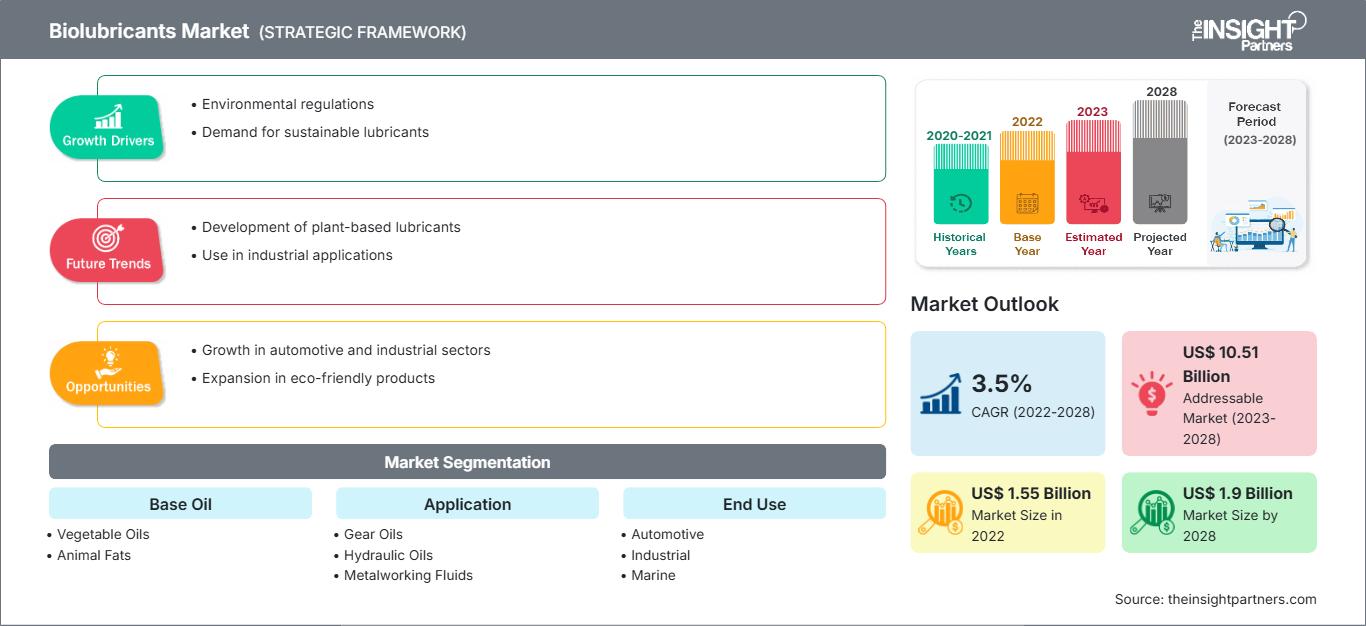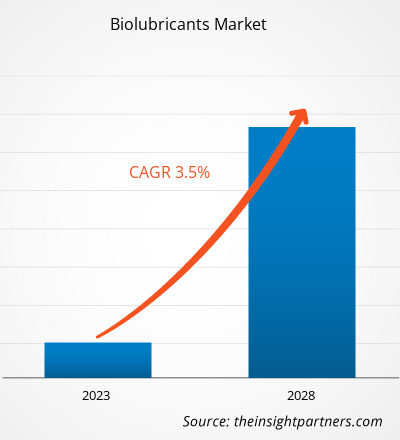Si prevede che il mercato dei biolubrificanti crescerà da 1.551,15 milioni di dollari nel 2022 a 1.902,41 milioni di dollari entro il 2028; si stima che registrerà un CAGR del 3,5% dal 2022 al 2028.
I biolubrificanti sono realizzati con oli derivati da vegetali e altre risorse rinnovabili, inclusi prodotti di origine animale. I biolubrificanti sono biodegradabili e non tossici per l'uomo e per gli ambienti acquatici. La biodegradabilità dei biolubrificanti svolge un ruolo fondamentale nelle applicazioni ad alto rischio di dispersione nell'ambiente. Inoltre, i biolubrificanti presentano punti di infiammabilità più elevati, viscosità costante e minori emissioni di vapori/nebbie d'olio, offrendo una maggiore sicurezza. I biolubrificanti producono anche meno emissioni e hanno una migliore adesione alle superfici metalliche. Sono utilizzati in varie applicazioni, tra cui motori, cambi, sistemi idraulici, motoseghe, grassi e motori a 2 tempi per motoscafi. I biolubrificanti sono ampiamente utilizzati in vari settori industriali, come quello automobilistico, marittimo, agricolo e forestale, minerario, edile, della trasmissione di potenza, alimentare e farmaceutico.
La crescita del mercato dei biolubrificanti è attribuita alla crescente domanda di biolubrificanti da parte di vari settori industriali, dovuta alla crescente consapevolezza ambientale, alle severe leggi ambientali che impongono l'uso di lubrificanti ecocompatibili e agli elevati costi di smaltimento dei lubrificanti non degradabili esistenti. In molti paesi, esistono normative che vietano l'uso di lubrificanti a base di olio minerale nelle acque interne. Tali normative stanno determinando la domanda di biolubrificanti per diverse applicazioni. Inoltre, poiché i biolubrificanti sono puliti e non tossici, il loro utilizzo è stato reso obbligatorio in applicazioni altamente sensibili come il settore forestale e quello marittimo in alcuni paesi del mondo. Nelle applicazioni marine, i biolubrificanti vengono utilizzati in diverse sezioni e processi di container, flotte cargo, petroliere e altre navi per scopi di lubrificazione. I biolubrificanti marini sono costituiti da oli motore, oli idraulici, oli per compressori, oli per guide di scorrimento, oli per ingranaggi, oli per il trasferimento di calore, grassi, oli per turbine e altri. Inoltre, la crescita del commercio internazionale via mare ha stimolato la domanda di biolubrificanti, grazie alla loro elevata efficienza e alla bassa capacità di emissione. Pertanto, un maggiore utilizzo di biolubrificanti nel settore marittimo offrirà opportunità redditizie per il mercato dei biolubrificanti durante il periodo di previsione.
Personalizza questo rapporto in base alle tue esigenze
Potrai personalizzare gratuitamente qualsiasi rapporto, comprese parti di questo rapporto, o analisi a livello di paese, pacchetto dati Excel, oltre a usufruire di grandi offerte e sconti per start-up e università
Mercato dei biolubrificanti: Approfondimenti strategici

-
Ottieni le principali tendenze chiave del mercato di questo rapporto.Questo campione GRATUITO includerà l'analisi dei dati, che vanno dalle tendenze di mercato alle stime e alle previsioni.
Approfondimenti di mercato
La crescente domanda da parte dell'industria automobilistica stimola la crescita del mercato dei biolubrificanti
Oli motore, fluidi per trasmissioni, oli per cambi, fluidi per freni e idraulici e altri oli per autoveicoli sono utilizzati nell'industria automobilistica e dei trasporti. I biolubrificanti sono utilizzati come mezzi antiattrito e assorbenti del calore e garantiscono un funzionamento fluido e affidabile, riducendo il rischio di guasti frequenti e contribuendo a migliorare la durata/il ciclo di vita del veicolo. I lubrificanti per autoveicoli vengono utilizzati per ridurre l'attrito e moderare il calore prodotto quando due superfici sono a contatto reciproco. Inoltre, gli oli motore di origine biologica presentano un tasso di biodegradazione intrinseco più elevato, una bassa tossicità per gli organismi acquatici e livelli molto bassi di bioaccumulo. Infine, la sostituzione degli oli a base di idrocarburi con prodotti biodegradabili è uno dei modi per ridurre gli effetti negativi dei lubrificanti sull'ecosistema. Con la crescente pressione normativa volta a migliorare l'efficienza dei consumi di carburante dei veicoli e a ridurre le emissioni di gas serra, si è registrato un notevole sviluppo nelle formulazioni di oli lubrificanti. Questi fattori stanno incrementando la domanda di biolubrificanti nel settore automobilistico.
Approfondimenti sugli oli base
A seconda dell'olio base, il mercato dei biolubrificanti è segmentato in oli vegetali, grassi animali e altri. Il segmento degli oli vegetali ha detenuto la quota maggiore del mercato nel 2022. Gli oli vegetali sono alternative preferite agli oli minerali per le basi lubrificanti grazie ad alcune proprietà intrinseche, tra cui elevata viscosità, elevato intervallo di ebollizione e biodegradabilità. Gli acidi grassi presenti nell'olio possono essere modificati chimicamente per formare esteri ad alto peso molecolare, che possono sostituire i lubrificanti convenzionali a base di olio minerale. Si prevede che questi fattori guideranno la crescita del mercato nel segmento degli oli vegetali.
EmeryOleochemicals LLC, Fuchs Petrolub SE, Carl Bechem GmbH, PANOLIN AG, Renewable Lubricants Inc, TotalEnergies SE, Shell Plc, RSC Bio Solutions LLC, Crevier Group Inc e Kluber Lubrication GmbH & Co KG sono tra i principali attori che operano nel mercato dei biolubrificanti. I principali attori adottano strategie come fusioni e acquisizioni e lanci di prodotti per espandere la propria presenza geografica e la propria base di consumatori.
Approfondimenti regionali sul mercato dei biolubrificanti
Le tendenze regionali e i fattori che influenzano il mercato dei biolubrificanti durante il periodo di previsione sono stati ampiamente spiegati dagli analisti di The Insight Partners. Questa sezione analizza anche i segmenti e la geografia del mercato dei biolubrificanti in Nord America, Europa, Asia-Pacifico, Medio Oriente e Africa, America Meridionale e Centrale.
Ambito del rapporto di mercato sui biolubrificanti
| Attributo del rapporto | Dettagli |
|---|---|
| Dimensioni del mercato in 2022 | US$ 1.55 Billion |
| Dimensioni del mercato per 2028 | US$ 1.9 Billion |
| CAGR globale (2022 - 2028) | 3.5% |
| Dati storici | 2020-2021 |
| Periodo di previsione | 2023-2028 |
| Segmenti coperti |
By Olio base
|
| Regioni e paesi coperti |
Nord America
|
| Leader di mercato e profili aziendali chiave |
|
Densità degli operatori del mercato dei biolubrificanti: comprendere il suo impatto sulle dinamiche aziendali
Il mercato dei biolubrificanti è in rapida crescita, trainato dalla crescente domanda degli utenti finali, dovuta a fattori quali l'evoluzione delle preferenze dei consumatori, i progressi tecnologici e una maggiore consapevolezza dei benefici del prodotto. Con l'aumento della domanda, le aziende stanno ampliando la propria offerta, innovando per soddisfare le esigenze dei consumatori e sfruttando le tendenze emergenti, alimentando ulteriormente la crescita del mercato.

- Ottieni il Mercato dei biolubrificanti Panoramica dei principali attori chiave
In evidenza nel rapporto
- Tendenze progressive nel settore dei biolubrificanti per aiutare gli operatori a sviluppare strategie efficaci a lungo termine
- Strategie di crescita aziendale adottate dalle aziende per garantire la crescita nei mercati sviluppati e in via di sviluppo
- Analisi quantitativa del mercato globale dei biolubrificanti dal 2020 al 2028
- Stima della domanda di biolubrificanti in vari settori
- Analisi delle cinque forze di Porter per illustrare l'efficacia di acquirenti e fornitori che operano nel settore dei biolubrificanti
- Sviluppi recenti per comprendere lo scenario competitivo del mercato e la domanda di biolubrificanti
- Tendenze e prospettive di mercato e fattori che regolano la crescita del mercato dei biolubrificanti
- Strategie illuminanti che sostengono l'interesse commerciale riguardo alla crescita del mercato, aiutando nel processo decisionale
- Dimensioni del mercato dei biolubrificanti in vari nodi di Mercato
- Panoramica dettagliata e segmentazione del mercato, nonché dinamiche del settore
- Dimensioni del mercato dei biolubrificanti in diverse regioni con promettenti opportunità di crescita
Il rapporto "Biolubricants Market Forecast to 2028" è uno studio specializzato e approfondito del settore chimico e dei materiali, incentrato sull'analisi delle tendenze del mercato dei biolubrificanti. Il rapporto mira a fornire una panoramica del mercato con una segmentazione dettagliata. Il mercato dei biolubrificanti è segmentato in base all'olio base, all'applicazione, all'uso finale e all'area geografica. In base all'olio base, il mercato è segmentato in oli vegetali, grassi animali e altri. In base all'applicazione, il mercato è segmentato in oli per ingranaggi, oli idraulici, fluidi per la lavorazione dei metalli, grassi e altri. In base all'uso finale, il mercato dei biolubrificanti è segmentato in automobilistico, industriale, marino, agricolo e forestale e altri. Il mercato è segmentato in cinque regioni principali: Nord America, Europa, Asia-Pacifico, Medio Oriente e Africa e Sud e Africa. America Centrale. Nel 2022, l'Europa ha dominato il mercato dei biolubrificanti. Si prevede che l'Asia-Pacifico registrerà il CAGR più elevato del mercato durante il periodo di previsione. Fattori come la crescente preoccupazione per l'ambiente e l'aumento dei costi del petrolio greggio stanno trainando la domanda di biolubrificanti in Europa. La domanda di biolubrificanti nell'Asia-Pacifico è direttamente proporzionale all'industrializzazione e alla produzione di veicoli nella regione. La crescita delle attività edilizie regionali e dei settori industriale e automobilistico accelera la crescita del mercato.
- Analisi storica (2 anni), anno base, previsione (7 anni) con CAGR
- Analisi PEST e SWOT
- Valore/volume delle dimensioni del mercato - Globale, Regionale, Nazionale
- Industria e panorama competitivo
- Set di dati Excel
Report recenti
Rapporti correlati
Testimonianze
Motivo dell'acquisto
- Processo decisionale informato
- Comprensione delle dinamiche di mercato
- Analisi competitiva
- Analisi dei clienti
- Previsioni di mercato
- Mitigazione del rischio
- Pianificazione strategica
- Giustificazione degli investimenti
- Identificazione dei mercati emergenti
- Miglioramento delle strategie di marketing
- Aumento dell'efficienza operativa
- Allineamento alle tendenze normative






















 Ottieni un campione gratuito per - Mercato dei biolubrificanti
Ottieni un campione gratuito per - Mercato dei biolubrificanti